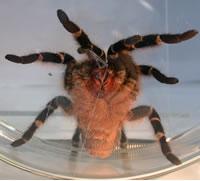 Tarantulas, giants of the spider world, use silk to glue their feet down.S. Niederegger and S. Gorb, Max Planck Society
Tarantulas, giants of the spider world, use silk to glue their feet down.S. Niederegger and S. Gorb, Max Planck SocietyMost spiders rely on their tiny claws and hairy feet to scurry up walls and cling to ceilings, but it seems that heavier spiders need an extra bit of sticking power. Researchers have found that tarantulas secrete gluey silk from their feet.
The discovery was made accidentally, by researchers at the Max Planck Institute for Developmental Biology in Tübingen, Germany.
They were studying the locomotion of a Costa Rican zebra tarantula (Aphonopelma seemanni). Thanks to the forgetfulness of a technician, who left an unattended camera rolling, little silken footprints were recorded.
"When we came back from a break and watched the film we found residue on the glass area where the spider had been walking," explains Stanislav Gorb, whose work is published in this week's Nature1.
The tracks were made of tiny fibres about one micrometre in diameter, 100 times thinner than a strand of hair, which were discarded from the spider's feet as it moved along. They seem to be made of the same protein as the silk spiders spin to make webs.
When the spiders were made to walk up a vertical piece of glass, the researchers watched the foot silk work to stop downward slides.
Up the waterspout
The observations are exciting because they reveal an attachment mechanism not seen in any other species of arachnid, says the team. And the finding may prompt a rethink of the evolution of spider silk.
The researchers suggest that initially all spiders had the ability to secrete silk from their feet, but lost the skill because they no longer needed it.
ADVERTISEMENT
Silk is usually produced by an organ called the spinneret, which is located on the lower abdomen. Gorb thinks that spinnerets may have evolved from leg appendages. "The finding that silk is directly coming from the feet supports this hypothesis," he says.
For now it is impossible to know whether foot silk pre-dates web spinning, or whether this type of tarantula evolved it separately. An examination of the genetics of the silk production should help to sort that out.
Visit our spinsilkfromtheir.html">newsblog to read and post comments about this story.
-
References
- GordS., et al. Nature, 443 . 407 ( 2006). | Article |
